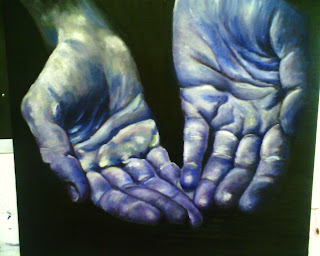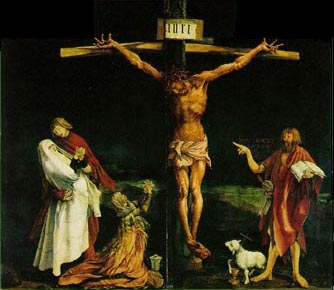
The body of Christ - Hans Holbein the younger
I first came across this image whilst reading Tate etc. magazine. The article examines the painting, and tries to understand what Holbein was telling us through this painting. To me Jesus looks almost alive, that the last breath has not let his body, or the first breath is entering after defeating death. I've never seen a composition like this before, and would love to see it in person. Over all this is an unusual painting, even the dimensions of the painting are unusual. It was interesting reading in the article about the possible interpretation of Jesus' outstretched middle finger, that in old texts of christian symbolism, the middle finger means 'examine, weigh'.
 Hands of God - Hannah Honeycombe (me!)
Hands of God - Hannah Honeycombe (me!)
I started this blog not knowing what to look at or where to start. I decided to look at a subject that is close to my heart, but that I had yet to integrate into my own art work. This is why I decided to look into modern Christian art. There was many famous artist I could have looked at like Bill Viola, but I wanted to find someone who's work I actually liked and could relate to my own practice. I have found many artists how have worked on religious themes, but I wanted to be fussy, and find someone who stated clearly that their work was not just on christian themes, but they themselves were/are a christian. This distinction may not make sense, or have much meaning to most people, but something I feel is important. Anyone could technically paint or produce art work on a particular subject, but to truly believe in what you are creating is completely different. I feel that I have been able to achieve this, and my current work is based on Paul Hobb's idea to always start art work with the bible.
I've also been researching into old masters, such as Leonardo da Vinci, Caravaggio, and Hans Holbein looking to see how they depicted stories from the bible, and whether there is any culture change in how this is done or viewed. I've especially been interested in the use of hands, and whether they play any significant role in the imagery, as this is what I have been focusing on in my latest series of paintings.
To support my work further I have looked into what the bible says about colour, and then how this has then related to art work through out history. For example blue is depicted as a 'heavenly' colour, and is used within the old testament to describe wall hangings in holy places, and as the colour of the holy spirit. This combined with the fact blue was traditional a different colour to create was why Mary is generally shown to be wearing blue clothing, when in reality Mary would never have been able to afford blue cloth.

Crucifixion - Grunewald
This is probably the best example of how a simple change in a hand gesture can completely change an image and add such depth to the painting, that I've been able to find. As with most painting from this era all the figures have dramatic hand gestures, but its the hands of Jesus that impress me most. To me they speak of great pain and suffering, more than I've known other artists to capture, and are extremely expressive.
As I've mentioned hands have been my main focus. I initially started my art work with the intention of creating a painting as a gift for my best-friend based on Issiah 49:15-16
'I will not forget you! See, I have engraved you on the palms of my hands.'
Which has developed into a collection of work studying hands, and the use of text in my work, exploring how to express the love of God in a visual way. I decided to use hands as its something everyone has, but can be used to achieve so many different things, from creating, healing, comforting, to destroying and harming. There are many famous paintings that have strong relations of this idea. For example Michelangelo's depiction of God reaching down from the heavens to create Adam in the Sistine Chapel. As the most common christian imagery is that of the crucifixion and therefore Jesus' hands, I decided it was important to learn why the nails are always shown to go through the palms of his hands. We now know that it this would not have happened as the weight of the body would have ripped the hands in half if the nail was placed through the palm, and that the nail would have gone through the wrist where bone would have kept it, and the body in place on the cross. Therefore does the palm have any significance or meaning that I was unaware of? As far as I have been able to discover it does not. The earliest known painting of Jesus' crucifixion was painted in the early 5th century, which meant it was down to the artists own interpretation of the bible, and knowledge of the events rather than on historical facts or evidence. It was not until about 30 years ago that the first crucified body was discovered by archaeologists. Historical evidence shows that the Romans would always remove the nails from the body, so that they could be used, but little was known about what then happened to the bodies, whether they were buried, or maybe even fed to the animals. However unless the nail remained in the body, there would be little evidence to explain their death, as the crucifixion would have left no mark on the bones. The only signs would have been to the skin, which would be long gone, unless as in the case of the body the archaeologists found, the nail had bent resulting in the Romans being unable to remove it, or if the nail had caused the bones to fracture.

The Dead Christ - Mantegna
I have been unable to find one journal that I could relate to and that could be useful for this blog. Instead I have been searching for information and articles that are beneficial to my work, and reading these, along with a variety of books.
http://www.jesuswalk.com/lords-supper/4_body.htm
http://www.culham.ac.uk/sg/symposium/2001/hack01.html
http://www.biblelands.org.uk/presence/index.htm
http://jonnybaker.blogs.com/jonnybaker/
http://www.moot.uk.net/
http://communiquejournal.org/index.html
http://www.uccf.org.uk/yourcourse/artists/resources/index.php





 Dali - Jesus by Maya (stencil artist), Cambridge
Dali - Jesus by Maya (stencil artist), Cambridge





